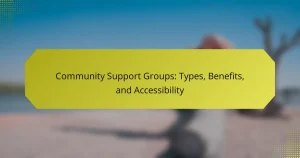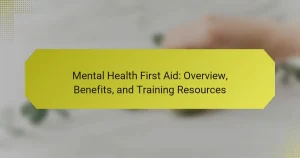Crisis intervention resources provide vital support for individuals in distress, addressing urgent mental health needs. This article explores various types, including hotlines, mobile crisis teams, and online platforms. It examines their availability and effectiveness, highlighting key attributes like accessibility and cultural competence. Additionally, it discusses how individuals can effectively access these resources for timely assistance.
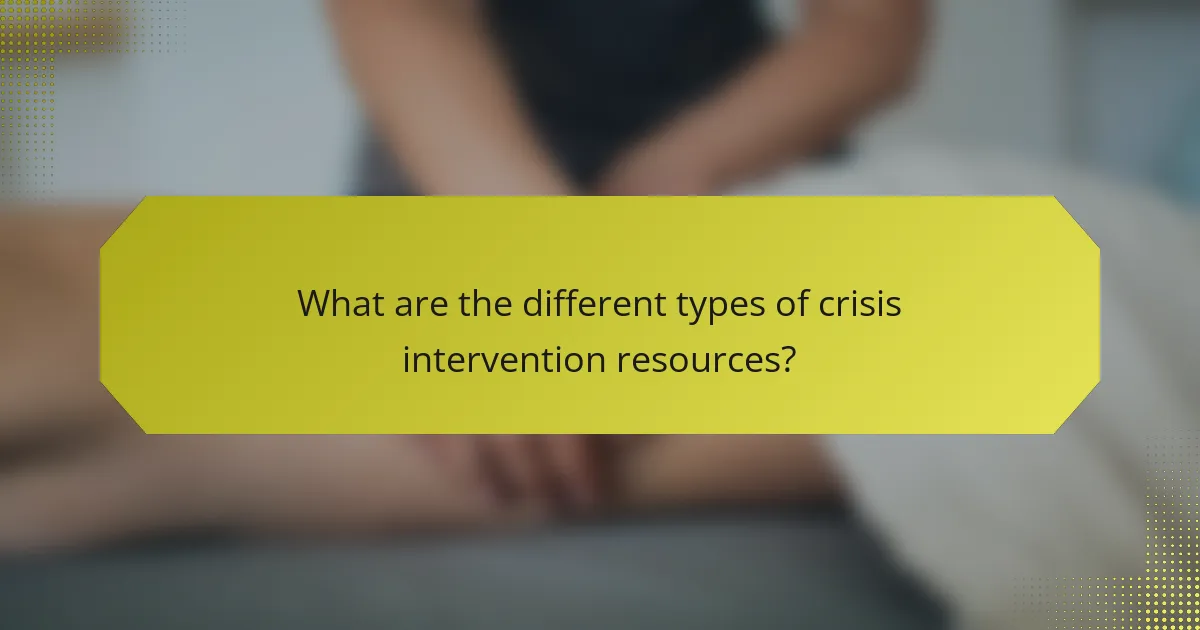
What are the different types of crisis intervention resources?
Crisis intervention resources include various types that cater to different needs. These resources encompass hotlines, mobile crisis teams, community mental health centres, online support platforms, and peer support groups. Each type varies in availability and effectiveness, depending on the specific situation and location. For instance, hotlines provide immediate support, while mobile crisis teams offer in-person assistance. Community mental health centres serve as ongoing resources for therapy and counselling. Online platforms offer accessibility, especially for those hesitant to seek in-person help. Peer support groups foster shared experiences and community connections, enhancing recovery through social support.
How do hotlines function in crisis intervention?
Hotlines function as immediate, accessible support for individuals in crisis, providing emotional assistance and resources. They operate through trained professionals who listen, assess needs, and offer guidance. Their effectiveness is enhanced by anonymity and 24/7 availability, allowing timely intervention. Unique attributes include specialised services for various crises, such as mental health, substance abuse, and domestic violence. As a result, hotlines play a crucial role in crisis intervention, helping to reduce distress and connect individuals to further support.
What are the steps to effectively use a crisis hotline?
To effectively use a crisis hotline, follow these steps: identify the need for help, gather necessary information, reach out to the hotline, communicate openly, and follow up if needed.
First, recognise when you or someone else requires support. Next, have relevant details ready, such as your location and the nature of the crisis. When contacting the hotline, ensure you are in a safe and quiet environment. Be honest and clear about your feelings and situation during the conversation. Finally, consider following up with a mental health professional if ongoing support is necessary.
What role do mobile crisis units play?
Mobile crisis units provide immediate, on-site support for individuals experiencing mental health emergencies. They help stabilise situations, reduce the need for hospitalisation, and connect individuals with ongoing care. These units typically consist of trained mental health professionals who assess and intervene in crises effectively. Their presence can significantly improve outcomes by offering timely assistance and resources tailored to individual needs.
What services do mobile crisis teams typically offer?
Mobile crisis teams typically offer immediate mental health support, assessment, and intervention services. They provide on-site assistance to individuals in crisis, ensuring safety and stabilisation. These teams often connect individuals to ongoing care and resources, enhancing community mental health support. Their effectiveness is rooted in timely response and tailored intervention strategies.
How do community-based resources support crisis intervention?
Community-based resources are vital in crisis intervention by providing immediate support and access to essential services. These resources include local hotlines, shelters, and mental health clinics that offer professional assistance and guidance. Their effectiveness stems from their accessibility and familiarity within the community, allowing individuals to seek help without stigma. Additionally, community resources often collaborate with local authorities and organisations to ensure a comprehensive response to crises. This integrated approach enhances the overall effectiveness of crisis intervention efforts.
What types of community organizations are involved?
Crisis intervention resources involve various community organisations, including mental health agencies, non-profits, and local government services. These organisations provide immediate support, counselling, and resources to individuals in crisis. Their effectiveness often hinges on collaboration and accessibility. For example, mental health agencies may offer 24/7 hotlines, while non-profits might focus on outreach programmes. Local government services can provide emergency response teams trained in crisis intervention. Each organisation plays a unique role, enhancing the overall support network available to those in need.
What is the significance of online crisis intervention platforms?
Online crisis intervention platforms are significant as they provide immediate support and resources for individuals in distress. These platforms increase accessibility to mental health services, enabling users to receive help anytime and anywhere. Their effectiveness is enhanced by trained professionals who can offer timely interventions, which can lead to reduced feelings of isolation and improved mental health outcomes. The unique attribute of these platforms is their ability to connect users with a network of support, fostering community and resilience during crises.
How effective are chat and text services in crisis situations?
Chat and text services are effective in crisis situations, providing immediate support and anonymity. These services often enable quicker responses compared to traditional methods. Studies show that text-based interventions can reduce feelings of isolation and increase the likelihood of seeking further help. Accessibility is a key attribute, allowing individuals to reach out anytime, which is crucial during emergencies. Unique aspects include the ability to communicate in a less intimidating format, appealing to those who may struggle with face-to-face interactions.
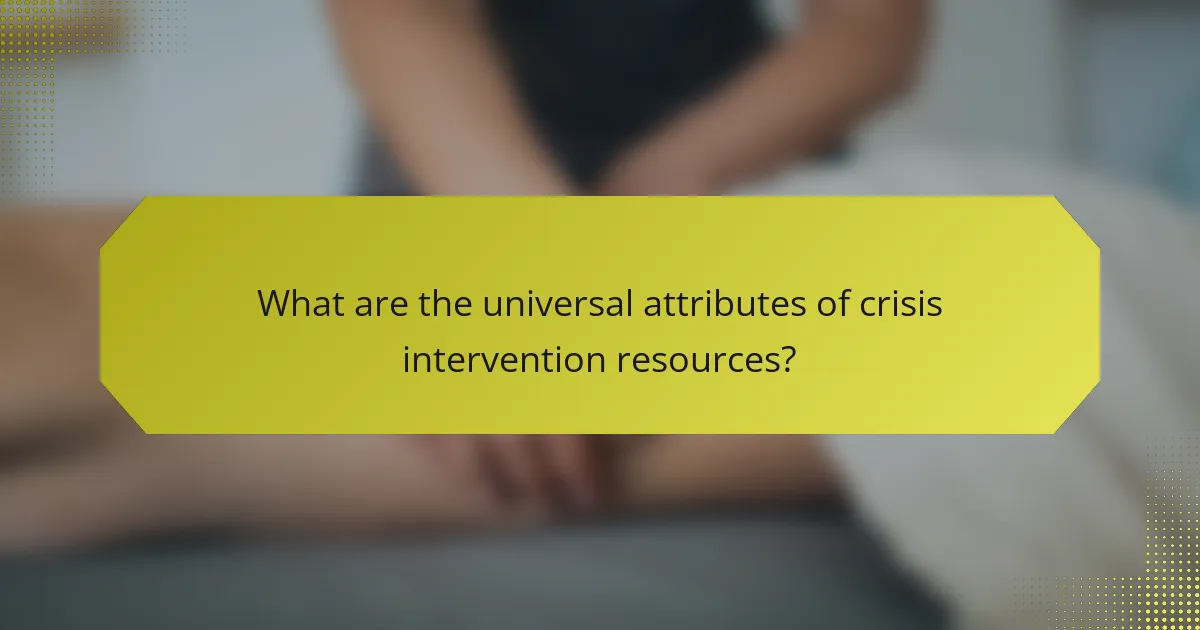
What are the universal attributes of crisis intervention resources?
Crisis intervention resources universally share essential attributes that enhance their effectiveness. Key attributes include accessibility, which ensures that resources are available to those in need, and responsiveness, which allows for timely intervention. Additionally, cultural competence is vital, enabling resources to address diverse backgrounds effectively. Evidence-based practices strengthen the credibility and success rates of interventions. Lastly, collaboration among various stakeholders enhances resource effectiveness by pooling expertise and support.
How accessible are crisis intervention resources?
Crisis intervention resources are increasingly accessible through various platforms and services. Availability varies by location, with many communities offering helplines, online chat services, and mobile apps. Effectiveness is often measured by response times and user satisfaction, which can differ based on the type of resource used. For example, 24/7 helplines typically provide immediate support, while local services may have specific hours.
What training do crisis intervention professionals receive?
Crisis intervention professionals typically receive training in psychology, crisis management, and communication skills. They often complete specialised programmes that cover assessment techniques, de-escalation strategies, and support resources. Many also participate in ongoing education to stay updated on best practices.
What are the common outcomes of crisis intervention?
Crisis intervention commonly leads to improved emotional stability, reduced anxiety, and enhanced coping skills. Participants often experience a sense of safety and support, which fosters resilience. Effectiveness varies based on the type of intervention and individual circumstances. Follow-up services can further enhance positive outcomes.
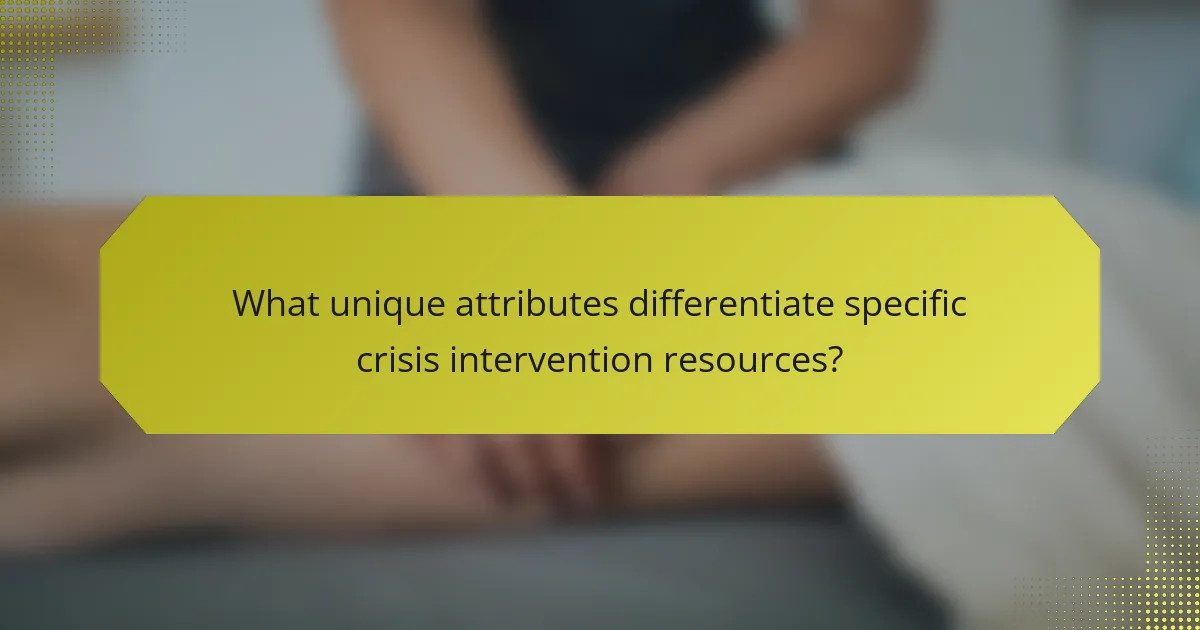
What unique attributes differentiate specific crisis intervention resources?
Crisis intervention resources differ based on their unique attributes, such as accessibility, specialisation, and response time. For instance, mobile crisis units offer immediate on-site support, while hotlines provide 24/7 availability. Specialised resources like trauma-informed care focus on specific populations, enhancing effectiveness. Additionally, community-based programmes often integrate local services, fostering a tailored approach to crisis situations.
What specialised services do youth crisis intervention programmes offer?
Youth crisis intervention programmes offer specialised services such as immediate emotional support, safety planning, crisis counselling, and resource referrals. These services are designed to address urgent mental health needs, stabilise individuals in distress, and connect them with ongoing support. Programmes often include unique attributes like tailored interventions for specific age groups and culturally sensitive approaches. Additionally, they may provide rare services such as peer support and family involvement initiatives, enhancing overall effectiveness in crisis management.
How do culturally specific crisis intervention resources enhance effectiveness?
Culturally specific crisis intervention resources significantly enhance effectiveness by ensuring relevance and relatability for diverse populations. These resources address unique community needs, fostering trust and engagement. For instance, culturally tailored approaches can improve communication and understanding, leading to better outcomes in crisis situations. Additionally, they often incorporate familiar practices and beliefs, making interventions more acceptable and effective.
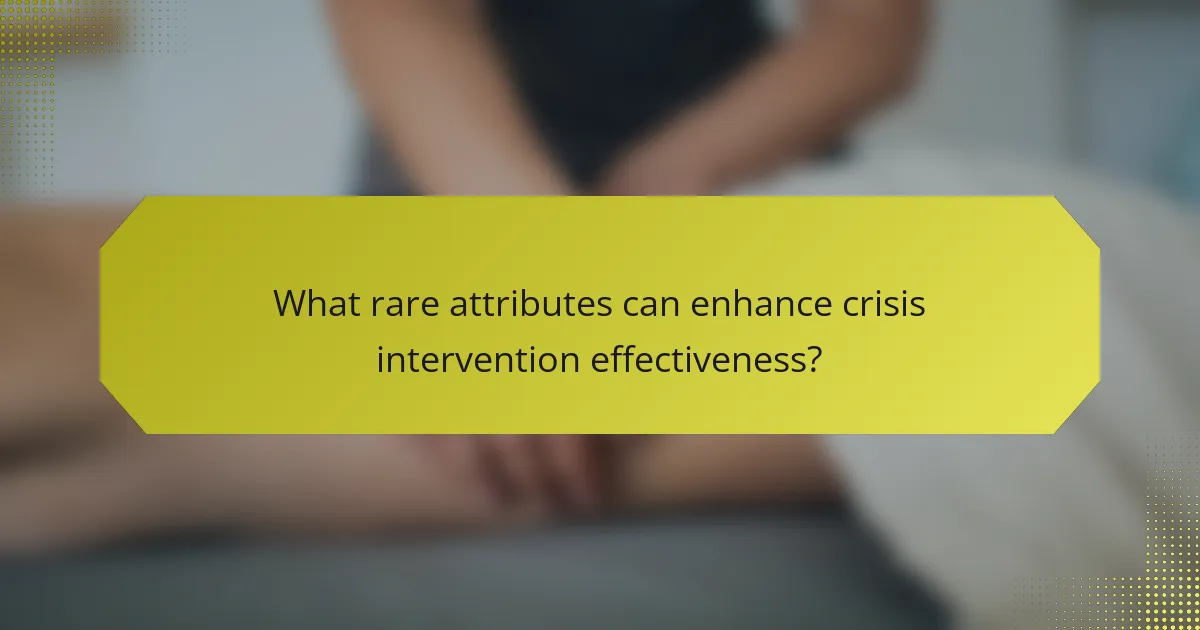
What rare attributes can enhance crisis intervention effectiveness?
Rare attributes that can enhance crisis intervention effectiveness include specialised training for responders, cultural competency, and real-time data access. Specialised training equips responders with unique skills tailored to specific crises, improving their response quality. Cultural competency allows responders to understand and respect diverse backgrounds, fostering trust and effective communication. Real-time data access provides critical insights, enabling timely and informed decision-making during interventions. These attributes contribute to a more effective crisis intervention framework.
What innovative technologies are being used in crisis intervention?
Innovative technologies in crisis intervention include AI-driven chatbots, virtual reality simulations, mobile apps for mental health support, and teletherapy platforms. These tools enhance accessibility, provide immediate assistance, and improve user engagement. AI chatbots can offer 24/7 support, while virtual reality can create immersive training for responders. Mobile apps facilitate real-time communication and resource sharing, making crisis intervention more effective and efficient.
How do peer support models contribute to crisis intervention?
Peer support models significantly enhance crisis intervention by providing emotional support and shared experiences. These models foster a sense of belonging and understanding, which is crucial during crises. Research indicates that individuals who engage in peer support often experience reduced feelings of isolation and increased resilience. This unique attribute of peer support is its ability to connect individuals through lived experiences, making interventions more relatable and effective. Moreover, the availability of trained peer supporters can improve access to crisis resources, ensuring timely assistance when needed.
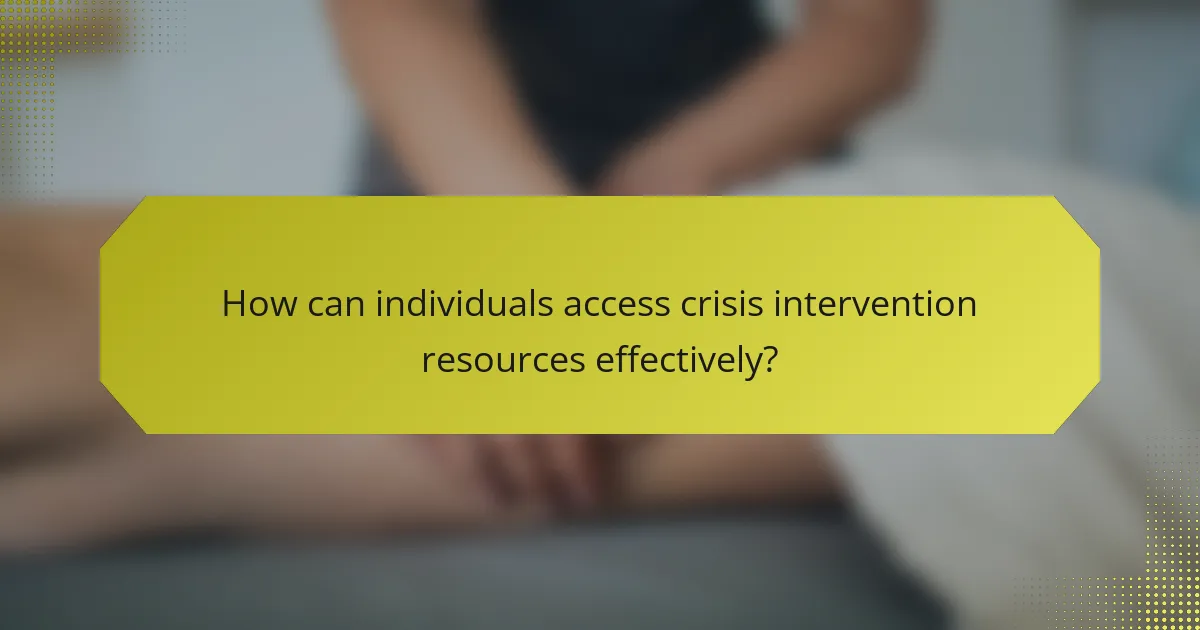
How can individuals access crisis intervention resources effectively?
Individuals can access crisis intervention resources effectively by utilising local hotlines, online platforms, and community services. Hotlines provide immediate support and can direct individuals to local resources. Online platforms offer chat services and information on mental health services. Community services, such as local mental health clinics, provide ongoing support and intervention programmes. These resources are often available 24/7, ensuring timely assistance. Utilising multiple channels increases the likelihood of finding the most suitable support based on individual needs.
What are the best practices for seeking help during a crisis?
Seek help during a crisis by utilising available resources effectively. Prioritise reaching out to crisis hotlines, mental health professionals, and community support groups.
1. Identify the type of crisis to find the appropriate resource.
2. Use national helplines for immediate support; they are often available 24/7.
3. Seek local mental health services for ongoing assistance and therapy.
4. Engage with community organisations that provide crisis intervention programmes.
These practices enhance the effectiveness of seeking help and ensure timely support.
What common mistakes should be avoided when using crisis resources?
To maximise the effectiveness of crisis intervention resources, avoid common mistakes like relying solely on online resources, neglecting follow-up support, and failing to assess the specific needs of individuals. Misunderstanding the limitations of these resources can lead to ineffective outcomes. Additionally, overlooking the importance of trained professionals in crisis situations can hinder proper intervention.
How can communities improve the effectiveness of crisis intervention resources?
Communities can enhance crisis intervention resources by fostering collaboration among local organisations, increasing awareness of available services, and providing training for responders. Effective communication channels ensure timely access to resources. Community engagement initiatives can further identify specific needs, tailoring interventions to local contexts. Regular evaluation of resource effectiveness allows for continuous improvement and adaptation.
